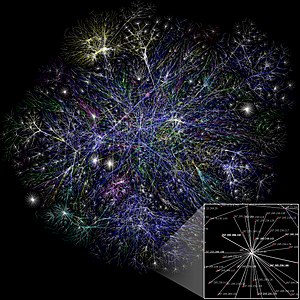This is a cross-post of a guest blog post (
Participating in Online Communities for Mutual Support) written for
Madelyn Griffith-Haynie's wonderful online resource,
http://www.ADDandSoMuchMore.com. Many thanks to Madelyn (CTP, CMC, A.C.T., MCC, SCAC, Foundational Concepts of the Intentionality Series) for given me the OK to cross post. It's all about reciprocity, so please pop across to have a look at her site.
 |
| This image was selected as a picture of the week on the Farsi Wikipedia for the 13th week, 2011. (Photo credit: Wikipedia) |
Personally and professionally, I don’t know what I would do without being a member of online communities.
I am constantly challenged to think and reflect, as well as affirmed or guided in some of the ideas I am developing.
On the social side, I have had the pleasure and privilege of ‘meeting’ a vast variety of people from around the world, including Madelyn, who are incredibly generous with their time, and with sharing their thinking.
You might be saying to yourself,
- “But I don’t have anything to say that hasn’t already been said,”
- “I don’t have time,” or
- “What if I say something wrong?”
I know I had similar concerns before I started getting involved in online communities.
So why might you want to get involved?
In July 2011 in her blog post
Creating Community Together, Madelyn threw down a challenge that read as follows:
“Let’s work together for the mutual good of our communities and our planet – becoming resources for each other because it is simply the right thing to do – meaning the thing that will create the kind of world we want – a world that works for EVERYONE.”
You may have already taken up her challenge and are comfortably participating in and contributing to online communities. But you may also be sitting on the fence and not feeling very comfortable about jumping into the online community spaces where you may feel you need to build your digital literacy skills before joining the conversations.
In this blog post I would like to describe what I mean by digital literacy skills, give a brief overview why your voice is important in online communities, and finally, I’ll provide a grab-bag guide to getting involved.
Why online communities?
Over a period of about 13 years I had become increasingly interested in how human beings interact and ‘learn’ in online spaces, especially when they are offered opportunities to become **immersed. An
immersive environment enables people to experience a variety of approaches and ideas, at the same time as exploring them intellectually.
During this period the Internet grew in popularity as a place for formal and informal learning, and hardware and software became more affordable. I have become increasingly excited by the potential of
eLearning and Mobile Learning (
mLearning). Being able to connect is providing a range of ways to co-construct understanding, to develop creative problem solving skills, and to become more culturally aware. This, however, entails a paradigm shift away from content to a greater focus on mutual support and synergistic thinking, as well as an increasing requirement for individuals to possess digital literacy skills.
**Immersive digital environment / experience: Adapted from gaming environments, references to immersive experiences illustrate instances where an online CoP member becomes immersed in the ‘narrative’ of the community and its interactions. As such, the member feels as though they are part of an online ‘universe’, where they have the option to create and design the spaces (Adams, 2004).
What is digital literacy?
Digital literacy can be broadly categorised in three distinct skills sets (Reynard, 2009).
- The first skill set is being able to navigate the Internet to locate and evaluate resources.
- The second skill set includes being able to create, repurpose, share and comment on resources hosted on the Internet.
These skills usually require some sort of account creation or membership to a community (for example, YouTube), as well as awareness of rights to use and re-use digital objects. Associated activities may include the sharing of links, images, or commenting on blogs.
To move to this stage of development is to move from the consumption of digital resources to the creation or adoption of an online identity.
- The third skill set involves the co-creation of ideas online and the active cultivation of an online identity. This requires a sophisticated level of digital literacy skills, whereby participants make sense of existing knowledge and reinterpret it in a way that fits within their existing knowledge framework, thereby, disconnecting, and reconnecting “knowledge fragments through knowledge creation” (Littlejohn, 2011, Para. 3). This sense-making will often occur within learning ecologies, online communities and networks (Siemens, 2003).
Healthy, established online communities tend to have members who have developed mutual trust and respect, and are reasonably confident in their digital literacy skills.
Other members, who remain readers of conversations and content (sometimes known as ‘lurkers’) are likely to have
developing digital literacies, less confidence in their online persona. That is not to say one is necessarily directly related to the other, but rather to highlight that full participation, which leads to an immersive experience,
requires digital literacies development.
Why your voice is important
I have explored online communities in a variety of situations, prior to taking on the position of national coordinator in New Zealand of a pilot project to develop a
Virtual Professional Learning and Development (VPLD) Model (initiated in October 2009 by the Ministry of Education, who also funded the project).
My initial experiences were in line with the current research findings of the time (e.g. Hallam, 2008; McDermott, 2002) – but it was one thing
reading about the challenges and another thing
experiencing them!
I found that a vibrant online community depended on establishing a balance between too little and too much communication, between facilitated and organic activities/contributions, and between confident and ‘developing’ contributors.
I discovered that, with encouragement and support, members could be mentored through the process of developing digital literacy skills. However, many members had not participated in an online community before, and were not aware of the level of engagement required to really get the ball rolling, so community enthusiasm waxed and waned.
I was frequently disappointed that I was the only one to respond to a post or discussion, or that responses were superficial.
Without a reasonable level of engagement from online community members, there was little sense of a mutual support network, and in turn, of their voices influencing developments and policy.
Nevertheless, slowly but surely, membership, momentum and the quality and quantity of contributions grew over the next 3½ years.
Some of the challenges
Time and opportunities are needed for the more confident members to ‘model’ some online community building behaviours, so that other members are able to build an identity within a newly formed group. Individual participants also face challenges that include (but are not limited to):
- unfamiliarity with netiquette and notions of reciprocity in an online space
- uncertainty of purpose
- lack of confidence in the value of their contributions
- workload and other life commitments (which impact the level of community engagement)
- little or no peer support
- lack of access to appropriate technology and connectivity.
A grab-bag guide to getting involved in online communities
One of the things you need to do, if you want to get involved, is join a community. First you’ll need to find an online community that is formed around a topic that interests you. This could be through recommendations from friends or colleagues, or through a simple online search.
Once you have found a likely community take a trip around – set by 30 or 40 minutes to dip into all the spaces on the community site, and get a feel for the tone of the conversations.
- If you don’t like the tone, don’t join the community.
- Don’t give up though – find another one that seems to be more your ‘fit’.
And then, once you have joined:
- Set up an online profile.
Start by considering what other members of this specific community would be interested in; keep it short and sweet initially. And don’t share anything you wouldn’t be comfortable sharing with someone if you met them face-to-face for the first time.
- Upload an image to your profile; it doesn’t have to be of you – it can be your dog, your cat, your garden, your car, or something meaningful to you.
An image helps people feel as though they are ‘getting to know you’ because, as humans, we are pretty visual creatures.
- Within two weeks of joining the community, find a blog post, resource, or online discussion that resonates with you in some way and ‘like’ it.
- Within one month of joining keep your eyes open for a blog post, resource, or online discussion that resonates with you in some way and leave a comment.
- In no longer than two months, locate a resource you think is interesting or useful, and share it with the community.
You only need to add a couple of sentences about why the resource caught your attention.
And don’t get disheartened if you don’t get any responses…other folks are going through the same online journey as you

LAST COMMENT from Madelyn
So NOW you know that if you found this information helpful, “reciprocity” means you INTERACT, right?
So THAT means that you do one or more of the following –
You:
- click “like” on the page (from the TOP on the WordPress Menubar for WordPress.com visitors – anyone can “like” at the bottom, near my tiny photo below, where I clicked to “like”)
- share it on one of your social networks, like FaceBook, LinkedIn, etc. (at the bottom of the article, on THIS blog)
- leave a comment (keep scrolling down for comments – AND you can reply to comments from others to get a full-fledged conversation going), or
- rate it five stars, found at the top – you’re pretty great about that already, btw!
As always, the goal is to affirm and acknowledge, not to “vote” or argue — so keep things totally positive as you interact, even if your point of view is completely different as you speak your truth ~ mgh
References
- McDermott, R. (2002). Knowing is a human act. Upgrade: The European Online Magazine for the IT Professional, 3(1), 8-10.
Related Articles from Ethos Consultancy
Related Articles ’round the ‘net

 Click here to access a thorough guide to learning outcomes(UCE Birmingham)
Click here to access a thorough guide to learning outcomes(UCE Birmingham) Click here for a briefer overview of learning outcomes and questions to ask yourself while writing them.
Click here for a briefer overview of learning outcomes and questions to ask yourself while writing them.














